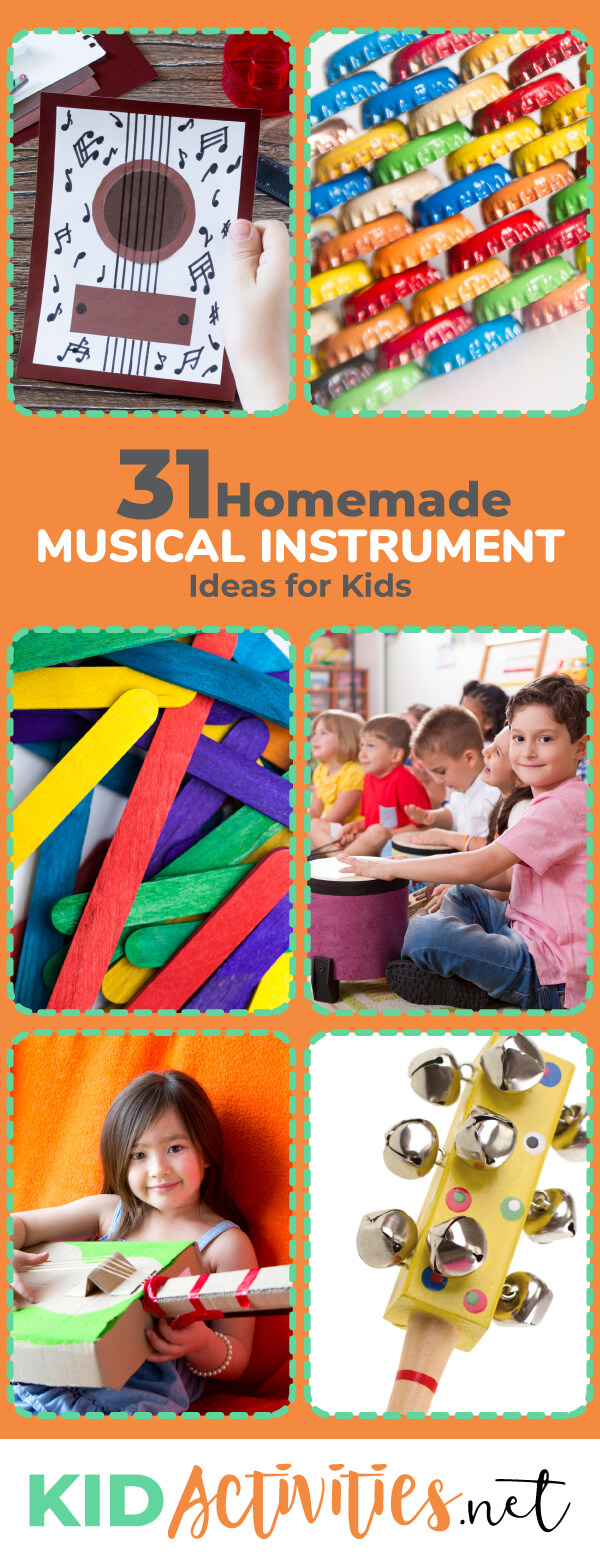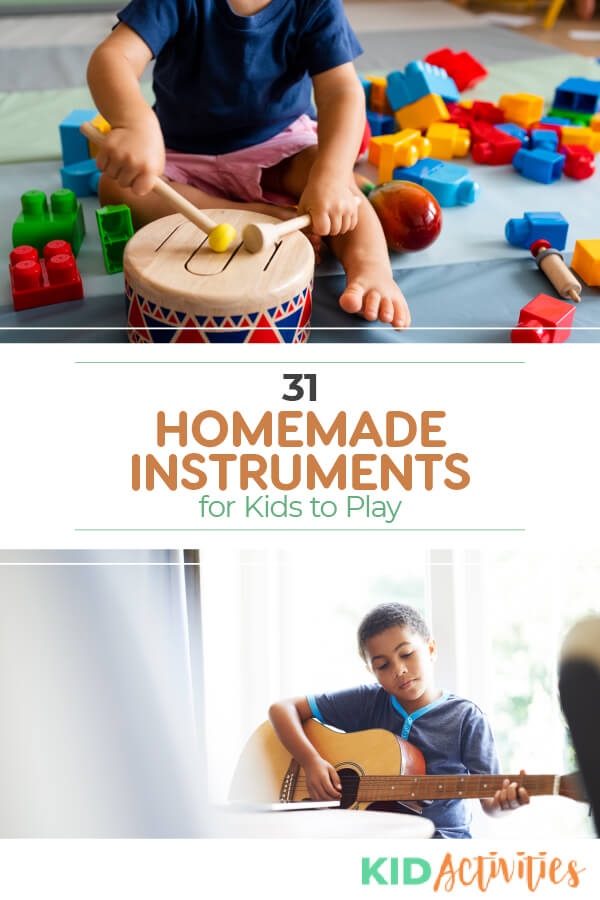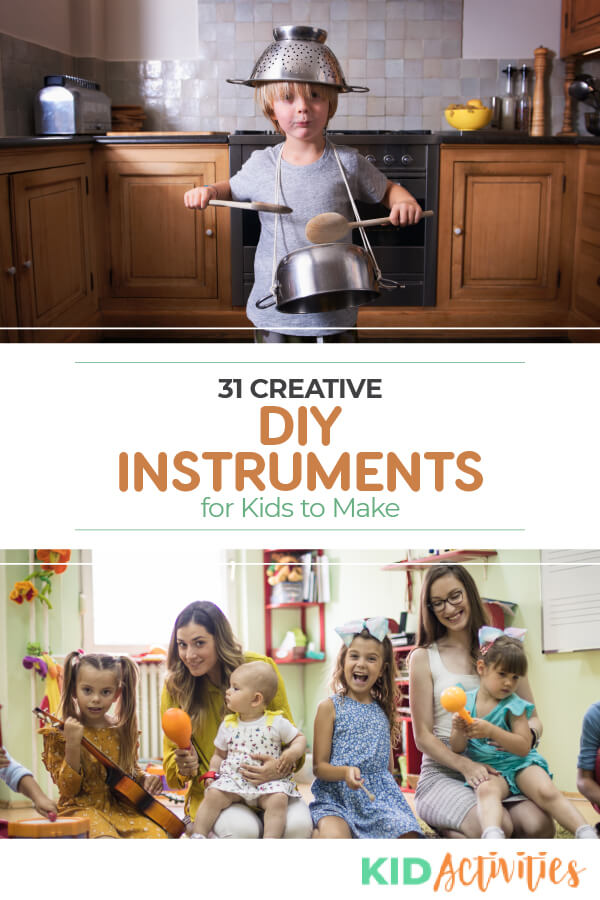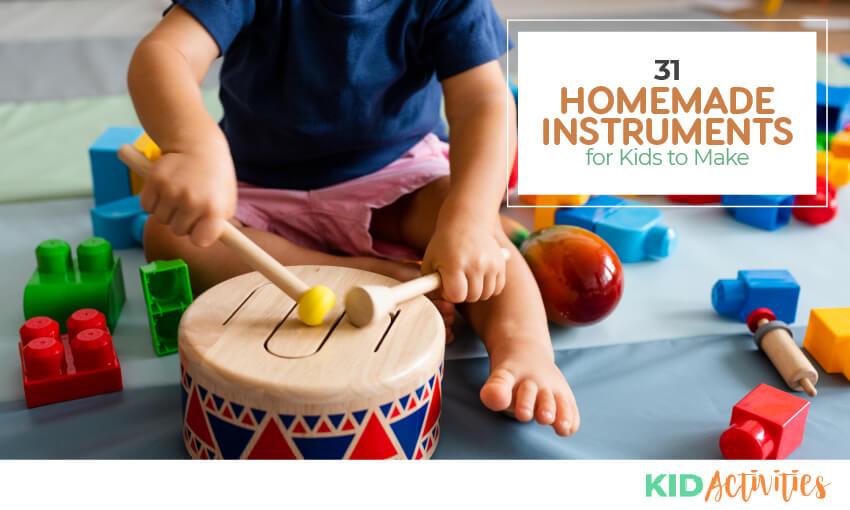Make amazing homemade musical instruments that really work, recycled from things you already have at home.
This list of 31 easy-to-make instruments is perfect for kids of all ages. Besides fun, exploring music is a critical part of healthy childhood development.
In this post, you will find homemade percussion, string, brass, and wind instruments. Start now and you’ll have a family band before you know it!

1. Basic Drum
Instructions
- Cut a piece of paper to fit around a can with a plastic lid; large coffee cans work well, but any size can be used.
- Decorate the paper with crayons and markers.
- Attach the paper around the can with tape.
- You can also use an empty plastic jug, or wooden bowl turned upside down or metal pot or bowl.
You can check out our list of best toddler drum sets as well.
2. Bongo Drum
Instructions
- Cut two pieces of paper to fit around two cardboard oatmeal containers with lids.
- Decorate the paper with crayons and markers.
- Attach the paper around both containers with tape.
- Set the containers side-by-side and tie them together with two long pieces of string or yarn.
- Tie one piece of string around the upper section of the containers and the other around the lower section.
- Place a dab of glue under the string in several spots to hold it in place. Play your bongos by tapping on the tops with your fingertips.
3. Bass Drum
This is an easy homemade instrument and kids tend to do it naturally. Turn a cooking pan over and beat on the bottom of it with a wooden spoon.
4. Belt Drum
Materials:
✓ Round box
✓ Belt
✓ Scissors or cutting tool
Instructions
- Collect a round box, such as an oatmeal box or a potato chip container.
- Carefully make two small slits, about 2 inches apart, near the top of the box.
- Thread the box onto a child’s belt (or a shortened adult belt).
5. Drum Stick Ideas
- Use hands to tap on the drums
- A wooden spoon, metal spoon, rubber spatula, whisk or a basting brush.
- Make drumsticks with two unsharpened pencils with erasers.
- Attach an empty thread spool on one end of the pencils or wrap a thick rubber band around one end of each pencil.
Have children experiment with a variety of sounds and tones they can make.
6. Tapping Ideas
- Have children tap together two wooden dowels.
- Children can also put metal thimbles on each finger and tap them together.
- TAP together two metal or wooden spoons, two walnut shells, or two metal pot lids.
7. Things to Ring
- Keys
- Set of metal measuring spoons
- A small set of wind chimes.
8. Things to Shake
- A container of toothpicks
- A container of nails or tacks or an envelope of flower seeds.
9. Pringles Can Shaker
Instructions
- Put pop can tabs/tops or beans inside of a Pringles can.
- Secure the plastic lid of the can with tape.
- Paint or cover the can with construction paper and shake it!
10. Musical Shakers
Use a large empty spool from a lanyard, curling ribbon, wire, etc. to make musical shakers.
Materials:
✓ Large Empty Spool
✓ Foamy Shape (Star, circle, etc.)
✓ Foam Brushes
✓ Paint
✓ Curling Ribbon
✓ Scissors
✓ Rice, Beans or Beads
✓ Glue
Instructions
- Paint the spool.
- Let it dry.
- Glue a foam shape over the opening on one end.
- Drop a few beans in the other end.
- Glue a foamy shape over that end to keep the beans inside.
- Cut long pieces of curling ribbon and tie it to the core of the spool.
- Curl with scissors.
11. Plastic Water Bottle Maracas
Materials:
✓ Empty plastic water bottles with their caps
✓ Masking tape (plain or bright colors)
✓ Paint and/or markers (of not using colored tape)
✓ Dried beans or popcorn kernels
Instructions
- Going horizontally, wrap the water bottle from top to bottom with masking tape. If using colored masking tape, alternate the colors to make a bright design.
- If using plain masking tape, decorate the maraca by drawing or painting designs on the masking tape.
- Fill the water bottle half-way with popcorn or dried beans. Replace bottle cap and shake!
12. Mini Maracas
Easy to make from empty film canisters and craft sticks.
Materials:
✓ Empty Film Canisters
✓ Craft Sticks
✓ Colored or Black Vinyl Tape
✓ Black Marker or Paint
✓ Rice, Beans, or Beads
✓ Scissors
Instructions
- Paint the craft sticks black.
- Decorate the sticks and the containers using colored vinyl tape.
- Cut a slit in the tops to hold the craft sticks securely. Fill containers half full with rice, beans or beads. Replace the tops.
- Push in the crafts sticks.
Source: Dawn of Morganton-North Carolina.
13. Paper Plate Maracas
Instructions
- Have kids paint their paper plates (eating-side down) any color and design they choose. The brighter the better!
- Once the paint is dry, fill one paper plate with dried beans, popcorn kernels, or anything that will make noise.
- Glue the paper plates together…and shake!
- Optional: Glue or staple long crepe paper streamers if desired.
14. Tambourine
Instructions
- Glue or staple two foil pie pans or paper plates together with the front sides are facing.
- Try to reuse paper plates that have only been used for sandwiches or dry foods.
- Paper plates can be decorated first with crayons or markers.
- Make holes about 2” apart around the rims of the plates or pans with a hole punch.
- Use string to tie a bell from each hole.
- You can also place a handful of dried beans or rice between the plates before attaching them together. Shake to play.
15. Triangle
Tie a string around the top of a wire coat hanger and bend the hook closed. Hold onto the string and hit the hanger with a metal spoon.
16. Finger Cymbals
Instructions
- Punch two holes in two identical small jar lids.
- Poke a small chenille stem through the holes and twist to make finger handles.
- The child puts one on each pointer finger and bangs them together.
17. Metal Pan Cymbals
Have children bang metal pan lids together.
18. Xylophone
Materials:
✓ Tall glasses or jars
✓ Water
✓ Mixing spoon
Instructions
- Fill the glasses or jars with different amounts of water.
- The more water in the glass, the lower the pitch will be.
- Having less water in the glass or jar will raise the pitch.
- To play, gently strike the glasses with a mixing spoon.
Note: This instrument should probably be played by older children in “the band” because of the use of glass.
19. Musical Glasses
These aren’t necessarily recycled but yes they are instruments
Materials:
✓ Drinking glasses
✓ Water
✓ Spoon
Instructions
- Fill drinking glasses with different amounts of water and tap on the glasses with a spoon.
- Have them listen carefully to detect the different sounds made.
20. Make Music with a Wine Glass
Materials:
A wine glass or champagne flute
Instructions
- Hold the glass as far down on the base of the stem as you can. Do not hold it on the flat bottom.
- Dip the index finger of your other hand into a glass of water. Take that finger and lightly rub it along the rim of your empty wine glass.
- This should produce a humming sound.
The more you practice, the more you’ll get a feel for how light or hard you should rub your finger on the glass to produce different sounds.
Homemade String Instruments
22. Guitar
Materials:
✓ Cereal box
✓ Scissors
✓ Duct tape
✓ Cardboard tube
✓ Rubber bands
Instructions
- Make a hole large enough for 4 or 5 rubber bands to lay across in the center of the cereal box.
- Make small cuts on the cardboard tube where the rubber bands place will be held.
- Cut a hole on the top of the cereal box.
- Insert the tube into the top of the cereal box and secure it with the duct tape.
- Place the rubber bands in the slits of the tube and lay across the hole in the middle of the box.
- Play some of your toddler’s favorite songs and encourage them to play along with the music.
Homemade Brass Instruments
23. Bracelet Bells
Instructions
- String three or four bells onto a chenille stem.
- Twist the ends together to form a bracelet.
24. Jingle Wand
Instructions
- Hold 5 OR 6 chenille stems together and tape them securely in place with electrician’s tape or masking tape.
- Thread a jingle bell on the untaped end of each chenille stem.
- Twist the end of the chenille around to hold the bell in place.
- Let your child shake the Jingle Wand to make the bells jingle.
25. Chimes
Materials:
✓ Ruler or stick
✓ Washers
✓ Nail polish
✓ String
✓ Mixing spoon
Instructions
- Hang the washers from the ruler or stick with pieces of string by wrapping the string around the ruler or stick and securing.
- Strike the washers with the mixing spoon to play.
Note: You can make this craft colorful by painting the washers first with different color nail polishes, such as red, gold, glittery, etc. Adults should supervise this part of the activity.
Homemade Wind Instruments
26. Kazoo
Materials:
✓ Toilet Paper Tubes
✓ Wax Paper
✓ Rubber Band
✓ Paint
Instructions
- Decorate a toilet paper tube with paint.
- Punch a hole about a half-inch down the tube.
- Put a circle of wax paper over one end and secure it with a rubber band.
- Now your children can play music from a recycled toilet paper tube.
27. Recorder
Instructions
- Cut a piece of paper of fit around a paper towel tube.
- Decorate the paper with crayons or markers and attach it to the tube with tape.
- Use the end of a pen or pencil to place a row of holes along one side of the tube.
- Squeeze one end of the tube together and staple it in the center, leaving two open portions on either side of the staple.
- Hum or sing into the open end.
28. Soda Straw Clarinet
An ordinary soda straw can be used to make a musical note as well as the funny noises you hear when you suck the last drop out of soda from a glass. Here, we will make a great musical clarinet!
Instructions
- Flatten about half an inch of the end of a paper drinking straw.
- Then cut a point in the flattened end.
- Put the flattened end into your mouth, and be careful not to touch the points with your lips, and blow hard.
- The points will vibrate rapidly and you will produce a musical note.
If you cut pieces of straws at various lengths, you can make many different notes, because the tone is changed by the amount of air vibrating inside the straw.
29. Bottles
Instructions
- Blow over the tops of bottles to make interesting sounds.
- Fill the bottles with different amounts of water to find out if the sounds you make differ.
30. Comb Buzzer
Materials:
Pocket comb
Tissue paper
Instructions
- Fold a piece of tissue paper over the tooth edge of a comb.
- To play, hum through the tissue paper.
31. Didgeridoo
If you take 1″ schedule 40 PVC pipe (inexpensive pipe for drinking water ) and apply a natural rim of beeswax on one end, you have a didgeridoo. You can cut this at different lengths to get higher/lower sounds. You could also paint this to be traditional.
How to play the didgeridoo:
The didgeridoo is an instrument from Australia that is easy to start learning but offers a way to bring some eclectic world flavor into your music life.
- Sit down. It will be more comfortable and easier to drone for a longer period of time if you’re sitting.
- Relax. Get your mouth wet, your lips loose, and your breath coming easy. Have water ready, if you’re a bit dry.
- Hold the didgeridoo in front of you. Find a comfortable way to hold it steady. Some people like to hold the end of the instrument with their feet.
- Choose your playing style. You can play the didgeridoo directly in front of your mouth, or off to the side of your lips. Each way has its own benefits, and one may be more comfortable for you.
- Loosen your lips and blow through them like, “Brbrbrbrbrbrbr.” If you are familiar with playing brass instruments, this will be something like getting ready to play the tuba.
- Bring your lips to the mouthpiece to seal, but not too hard. You want to leave room for your lips to move a little.
- Blow the same loose raspberry. You may make some ugly noises at first, but the didgeridoo will help you find the right note by tightening or loosening your lips.
- If you’re tooting a high note like a trumpet, you may either be holding your lips too tight or blowing too hard. You’re not trying to move the air through the tube, you’re just trying to get it to vibrate.
- Don’t hum into the tube. (At least, not yet.) That’s not how you get the drone started.
- If you’ve found the right vibration, you should be getting a low, rumbly note out of the didgeridoo. It should be easy to maintain the note with just a little bit of air pressure. This is called the drone.
What To Do With Homemade Musical Instruments
- Start a program green band (Green-because it’s made from ‘recycled’ materials). Invite children to join the musical group.
- Form a marching band.
- Have a parade. Great for holiday celebrations.
Perform
- Practice, practice, practice, then put on a show for a school assembly, a few of the classrooms and/or a parents’ night!
- How about the Marching Band or parade?
- You can also take the group “on the road” and entertain an assisted living facility or another community group with your homemade musical instruments. Check out some more service project ideas.
No matter what you choose to do with the instructions:
- Show children how to play the instruments.
- Play along with a piece of music Start out by playing some popular toddler songs with which they can play their instruments. (Maybe sing with them too?).
- Encourage youth to listen for the beat of the song and match their strokes to the tempo of the music.
- Give children a choice. Before they choose their final “Band Instrument” let them play from a variety.
- Put on some lively music and have the child practice the instrument. Because it will be loud–you could practice outside when the weather is nice!
- Consider choosing an instrument for yourself and join the children’s’ Instrument Parade!
- It’s not enough to just make the instruments – Now have some fun with them.

Visit the Music in our Schools and After School Programs Category for more ideas!



